2005–2024 Time–Space Features of VT Seismicity at Stromboli: New Insights into the Volcano Plumbing System and Link to Effusive Eruptions
Abstract
1. Introduction
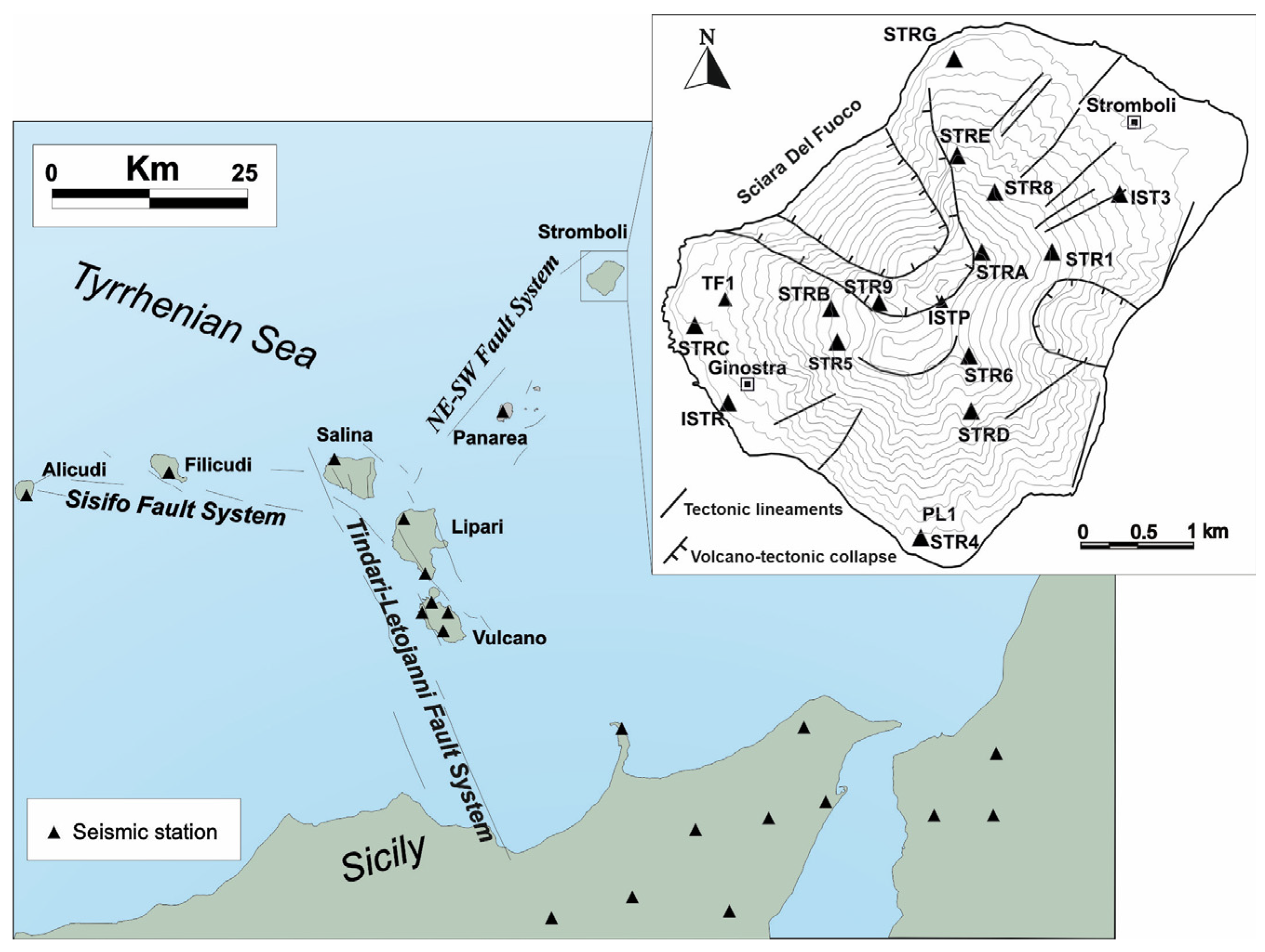
- (1)
- (2)
2. The Seismic Network
3. Seismic Data
4. Earthquake Relocations
5. Discussion and Conclusions
- -
- A shallower seismicity covers the first 4–5 km below Stromboli island, showing occurrence times mainly in 2006–2007 and in 2019–2024 (Figure 6), with a rather unique first event recorded on 3 July 2019 (n. 49 in Table 1) that took place only one minute before the paroxysm. Shallow seismicity indicates a source positioned under the Stromboli summit area, referable to the position of the HP magma reservoir. Its occurrence reflects changes in the stress field caused by LP magma ascent and mixing processes with HP ([38]; Figure 7).
- -
- -
- An intermediate seismicity (at depth of ca. 4.0–6.0 km b.s.l.,) showed an upward shifting of the sources toward north-east (Figure 7), suggesting, at these depths, the transfer of the plumbing system toward the actual Stromboli cone position.
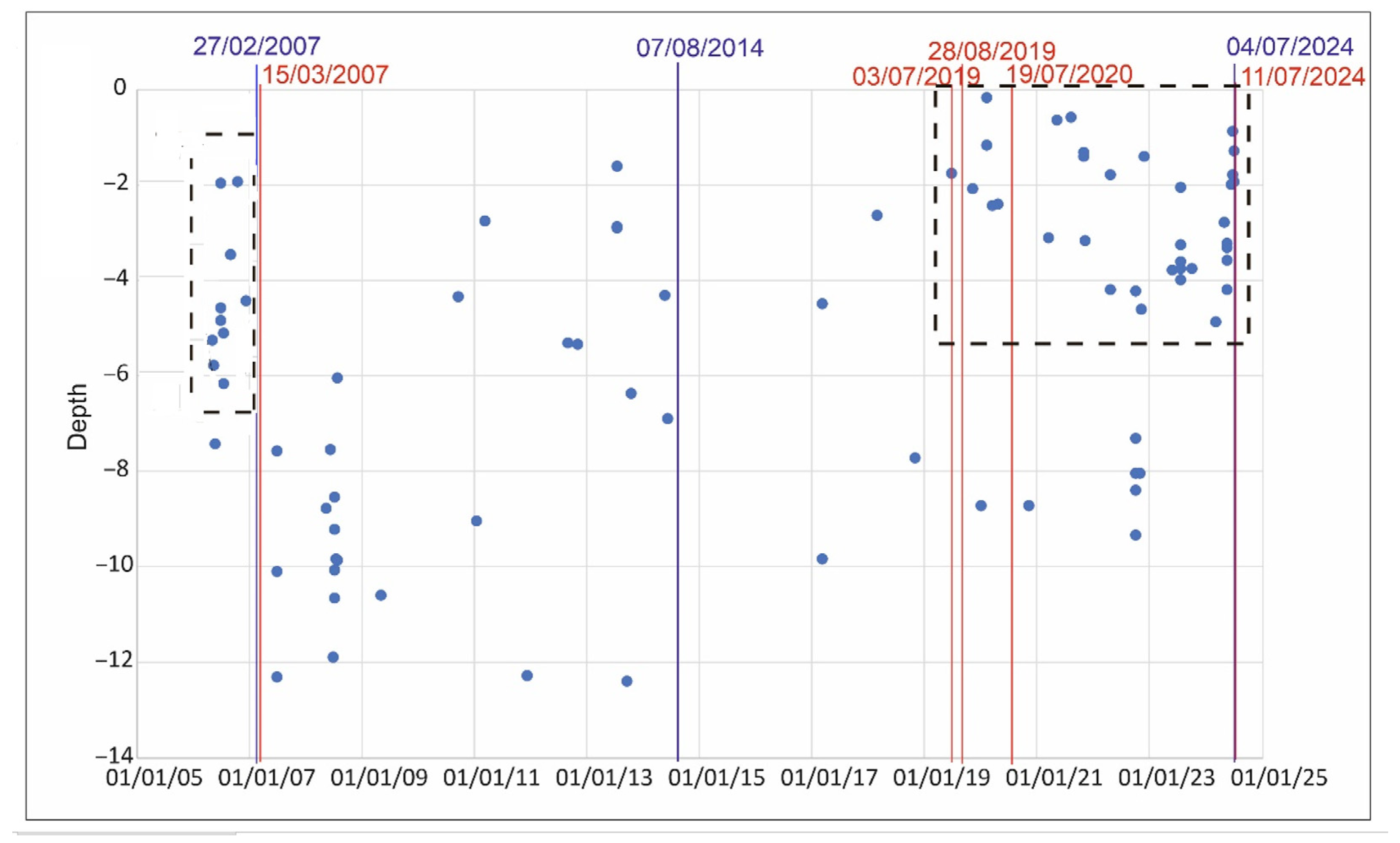

Author Contributions
Funding
Institutional Review Board Statement
Informed Consent Statement
Data Availability Statement
Acknowledgments
Conflicts of Interest
References
- Francalanci, L.; Lucchi, F.; Keller, J.; De Astis, G.; Tranne, C.A. Eruptive, volcano-tectonic and magmatic history of the Stromboli volcano (north-eastern Aeolian archipelago). Geol. Soc. Lond. Mem. 2013, 37, 397–471. [Google Scholar] [CrossRef]
- Francalanci, L.; Davies, G.R.; Lustenhouwer, W.; Tommasini, S.; Mason, P.R.D.; Ponticelli, S. Intra-grain Sr isotope evidence for crystal recycling and multiple magma reservoir in the recent activity of Stromboli volcano, Southern Italy. J. Petrol. 2005, 46, 1997–2021. [Google Scholar] [CrossRef]
- Lucchi, F.; Keller, J.; De Astis, G.; Francalanci, L.; Tranne, C.A. Geological Map of Stromboli, Scale 1:10 000 (Aeolian Archipelago); The Geological Society of London: London, UK, 2013; Available online: https://hdl.handle.net/11585/373545 (accessed on 7 July 2024).
- Tibaldi, A.; Corazzato, C.; Apuani, T.; Cancelli, A. Deformation at Stromboli volcano (Italy) revealed by rock mechanics and structural geology. Tectonophysics 2003, 361, 187–204. [Google Scholar] [CrossRef]
- Romagnoli, C. Characteristics and morphological evolution of the Aeolian volcanoes from the study of submarine portions. In The Aeolian Islands Volcanoes; Lucchi, F., Peccerillo, A., Keller, J., Tranne, C.A., Rossi, P.L., Eds.; Memoirs; Geological Society of London: London, UK, 2013; Volume 37, pp. 13–26. [Google Scholar] [CrossRef]
- Ventura, G. Kinematics of the Aeolian volcanism (Southern Tyrrhenian Sea) from geophysical and geological data. Geol. Soc. Lond. Mem. 2013, 37, 3–11. [Google Scholar] [CrossRef]
- Tibaldi, A.; Corazzato, C.; Marani, M.; Gamberi, F. Subaerial-submarine evidence of structures feeding magma to Stromboli Volcano, Italy, and relations with edifice flank failure and creep. Tectonophysics 2009, 469, 112–136. [Google Scholar] [CrossRef]
- Finizola, A.; Sortino, F.; Lenat, J.F.; Valenza, M. Fluid circulation at Stromboli volcano (Aeolian Islands, Italy) from self-potential and CO2 surveys. J. Volc. Geoth. Res. 2002, 116, 1–18. [Google Scholar] [CrossRef]
- Di Carlo, I.; Pichavant, M.; Rotolo, S.G.; Scaillet, B. Experimental crystallization of a high-Karcbasalt: The golden pumice, Stromboli volcano (Italy). J. Petrol. 2006, 47, 1317–1343. [Google Scholar] [CrossRef]
- Metrich, N.; Bertagnini, A.; Muro, A.D. Conditions of magma storage, degassing and ascent at stromboli: New insights into the volcano plumbing system with inferences on the eruptive dynamics. J. Petrol. 2010, 51, 603–626. [Google Scholar] [CrossRef]
- James, M.R.; Lane, S.L.; Chouet, B.A. Gas slug ascent through changes in conduit diameter: Laboratory insights into a volcano-seismic source process in low-viscosity magmas. J. Geophys. Res. 2006, 111, B05201. [Google Scholar] [CrossRef]
- Métrich, N.; Bertagnini, A.; Landi, P.; Rosi, M.; Belhadj, O. Triggering mechanism at the origin of paroxysms at Stromboli (Aeolian Archipelago, Italy): The 5 April, 2003 eruption. Geophys. Res. Lett. 2005, 32, L10305. [Google Scholar] [CrossRef]
- Landi, P.; Francalanci, L.; Pompilio, M.; Rosi, M.; Corsaro, R.A.; Petrone, C.M.; Nardini, I.; Miraglia, L. The December 2002–July 2003 effusive event at Stromboli volcano, Italy: Insights into the shallow plumbing system by petrochemical studies. J. Volcanol. Geotherm. Res. 2006, 155, 263–284. [Google Scholar] [CrossRef]
- Calvari, S.; Nunnari, G. Statistical Insights on the Eruptive Activity at Stromboli Volcano (Italy) recorded from 1879 to 2023. Remote Sens. 2023, 15, 4822. [Google Scholar] [CrossRef]
- INGV. Bollettino Settimanale sul Monitoraggio Vulcanico Geochimico e Sismico del Vulcano Stromboli del 2024-07-09. 2024. Available online: https://www.ct.ingv.it/index.php/monitoraggio-e-sorveglianza/prodotti-del-monitoraggio/bollettini-settimanali-multidisciplinari/918-bollettino-Settimanale-sul-monitoraggio-vulcanico-geochimico-e-sismico-del-vulcano-Stromboli-del-2024-07-09/file (accessed on 10 October 2024).
- Andronico, D.; Del Bello, E.; D’Oriano, C.; Landi, P.; Pardini, F.; Scarlato, P.; Vitturi, M.D.M.; Taddeucci, J.; Cristaldi, A.; Ciancitto, F.; et al. Uncovering the eruptive patterns of the 2019 double paroxysm eruption crisis of Stromboli volcano. Nat. Commun. 2021, 12, 4213. [Google Scholar] [CrossRef]
- Giordano, G.; De Astis, G. The summer 2019 basaltic Vulcanian eruptions (paroxysms) of Stromboli. Bull. Volcanol. 2021, 83, 1. [Google Scholar] [CrossRef]
- Calvari, S.; Spampinato, L.; Bonaccorso, A.; Oppenheimer, C.; Rivalta, E.; Boschi, E. Lava effusion a slow fuse for paroxysms at Stromboli volcano? Earth Planet. Sci. Lett. 2011, 301, 317–323. [Google Scholar] [CrossRef]
- Aiuppa, A.; Bertagnini, A.; Metrich, N.; Moretti, R.; Di Muro, A.; Liuzzo, M.; Tamburello, G. A model of degassing for Stromboli volcano. Earth Planet. Sci. Lett. 2010, 295, 195–204. [Google Scholar] [CrossRef]
- Ripepe, M.; Pistolesi, M.; Coppola, D.; Donne, D.; Genco, R.; Lacanna, G.; Laiolo, M.; Marchetti, E.; Ulivieri, G.; Valade, S. Forecasting effusive dynamics and decompression rates by magmastatic model at open-vent volcanoes. Sci. Rep. 2017, 7, 3885. [Google Scholar] [CrossRef] [PubMed]
- INGV. Bollettino Settimanale sul Monitoraggio Vulcanico Geochimico e Sismico del Vulcano Stromboli del 2024-07-16. 2024. Available online: https://www.ct.ingv.it/index.php/monitoraggio-e-sorveglianza/prodotti-del-monitoraggio/bollettini-settimanali-multidisciplinari/920-bollettino-Settimanale-sul-monitoraggio-vulcanico-geochimico-e-sismico-del-vulcano-Stromboli-del-2024-07-16/file (accessed on 10 October 2024).
- Falsaperla, S.; Spampinato, S. Tectonic seismicity at Stromboli volcano (Italy) from historical data and seismic records. Earth Planet. Sci. Lett. 1999, 173, 425–437. [Google Scholar] [CrossRef]
- Falsaperla, S.; Alparone, S.; Spampinato, S. Seismic features of the June 1999 tectonic swarm in the Stromboli volcano region, Italy. J. Volcanol. Geotherm. Res. 2003, 125, 121–136. [Google Scholar] [CrossRef]
- Martini, M.; Giudicepietro, F.; D’Auria, L.; Esposito, A.M.; Caputo, T.; Curciotti, R.; De Cesare, W.; Orazi, M.; Scarpato, G.; Caputo, A.; et al. Seismological monitoring of the February 2007 effusive eruption of the Stromboli volcano. Ann. Geophys. 2007, 50, 775–788. [Google Scholar] [CrossRef]
- Gambino, S.; Scaltrito, A. Volcanic-tectonic seismicity at Stromboli (2005–2016). J. Volcanol. Geotherm. Res. 2018, 350, 1–6. [Google Scholar] [CrossRef]
- D’Auria, L.; Giudicepietro, F.; Martini, M.; Orazi, M. The April–May 2006 Volcano-Tectonic Events at Stromboli Volcano (Southern Italy) and their Relation with the Magmatic System. Earth Prints Repository Open Archives. Available online: http://hdl.handle.net/2122/1506 (accessed on 7 July 2024).
- Alparone, S.; Barberi, G.; D’Amico, S.; Di Grazia, G.; Giampiccolo, E.; Maiolino, V.; Mostaccio, A.; Musumeci, C.; Scaltrito, A.; Scarfì, L.; et al. Aeolian Seismic Catalog 2000–2019 (AeolianSC_2000_2019) (Version 1) [Data Set]; INGV: Rome, Italy, 2023. [Google Scholar] [CrossRef]
- Barberi, G.; Di Grazia, G.; Ferrari, F.; Firetto Carlino, M.; Giampiccolo, E.; Maiolino, V.; Mostaccio, A.; Musumeci, C.; Scaltrito, A.; Sciotto, M.; et al. Aeolian Islands Revised Seismic Catalog from 2020 (AeolianRSC2020) (Version 1) [Data Set]; Istituto Nazionale di Geofisica e Vulcanologia (INGV): Rome, Italy, 2020. [Google Scholar] [CrossRef]
- Lahr, J.C. HYPOELLIPSE/VERSION 2.0: A Computer Program for Determining Local Earthquake Hypocentral Parameters, Magnitude, and first Motion Pattern; Open-File Report 89/116; U.S. Geological Survey: Reston, VA, USA, 1979; p. 81.
- Martinez-Arevalo, C.; Musumeci, C.; Patane, D. Evidence of a partial melt zone beneath Stromboli volcano (Italy) from inversion of teleseismic receiver functions. Terra Nova 2009, 21, 386–392. [Google Scholar] [CrossRef]
- Patanè, D.; Barberi, G.; De Gori, P.; Cocina, O.; Zuccarello, L.; Garcia-Yeguas, A.; Castellano, M.; D’Alessandro, A.; Sgroi, T. The shallow magma chamber of Stromboli volcano (Italy). Geophys. Res. Lett. 2017, 44, 6589–6596. [Google Scholar] [CrossRef]
- Richter, C.F. Elementary Seismology; Freeman: San Francisco, CA, USA, 1958. [Google Scholar]
- Statz-Boyer, P.; Thurber, C.; Pesicek, J.; Prejean, S. High precision relocation of earthquakes at Iliamna Volcano, Alaska. J. Volcanol. Geotherm. Res. 2009, 184, 323–332. [Google Scholar] [CrossRef]
- Waldhauser, F.; Ellsworth, W.L. A double-difference earthquake location algorithm: Method and application to the northern Hayward fault. Bull. Seism. Soc. Am. 2000, 90, 1353–1368. [Google Scholar] [CrossRef]
- Waldhauser, F. HypoDD: A Computer Program to Compute Double-Difference Earthquake Locations; Open-File Report 01-113; U.S. Geological Survey: Reston, VA, USA, 2001.
- Got, J.; Fréchet, J.; Klein, F.W. Deep fault plane geometry inferred from multiplet relative relocation beneath the south flank of Kilauea. J. Geophys. Res. 1994, 99, 15375–15386. [Google Scholar] [CrossRef]
- Gambino, S.; Milluzzo, V.; Scaltrito, A.; Scarfì, L. Relocation and focal mechanisms of earthquakes in the south-central sector of the Aeolian Archipelago: New structural and volcanological insights. Tectonophysics 2012, 524–525, 108–115. [Google Scholar] [CrossRef]
- Landi, P.; D’oRiano, C.; Petrelli, M.; Nazzari, M.; Andronico, D. Inferences on the magmatic plumbing system at Stromboli volcano (Italy) from trace element geochemistry of matrix glasses and minerals in different types of explosive eruptions. Contrib. Mineral Petrol. 2022, 177, 96. [Google Scholar] [CrossRef]
- Di Stefano, F.; Mollo, S.; Ubide, T.; Petrone, C.M.; Caulfield, J.; Scarlato, P.; Nazzari, M.; Andronico, D.; Del Bello, E. Mush cannibalism and disruption recorded by clinopyroxene phenocrysts at Stromboli volcano: New insights from recent 2003–2017 activity. Lithos 2020, 360–361, 105440. [Google Scholar] [CrossRef]
- Petrone, C.M.; Mollo, S.; Gertisser, R.; Buret, Y.; Scarlato, P.; Del Bello, E.; Andronico, D.; Ellis, B.; Pontesilli, A.; De Astis, G.; et al. Magma recharge and mush rejuvenation drive paroxysmal activity at Stromboli volcano. Nat. Commun. 2022, 13, 7717. [Google Scholar] [CrossRef] [PubMed]
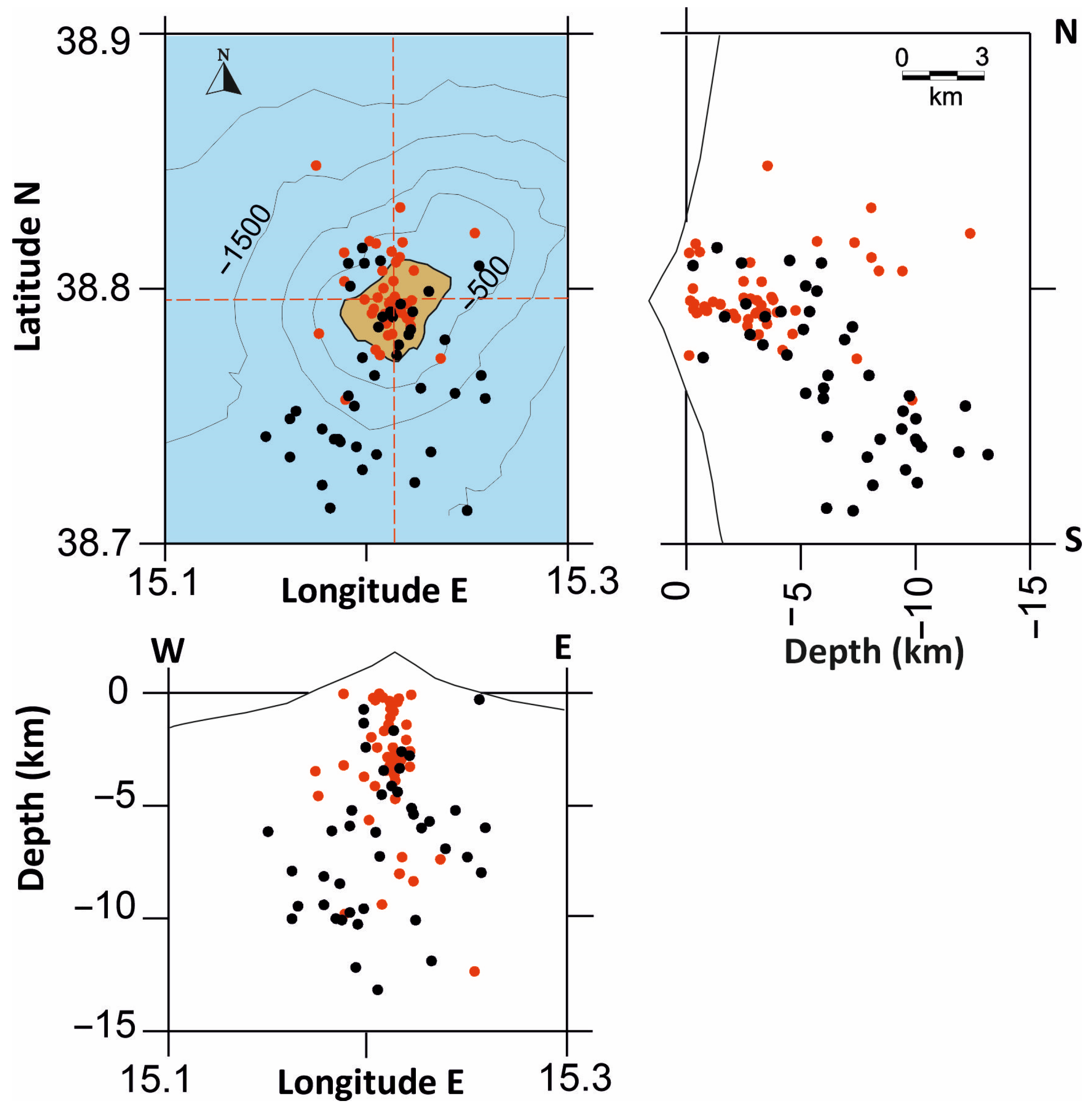
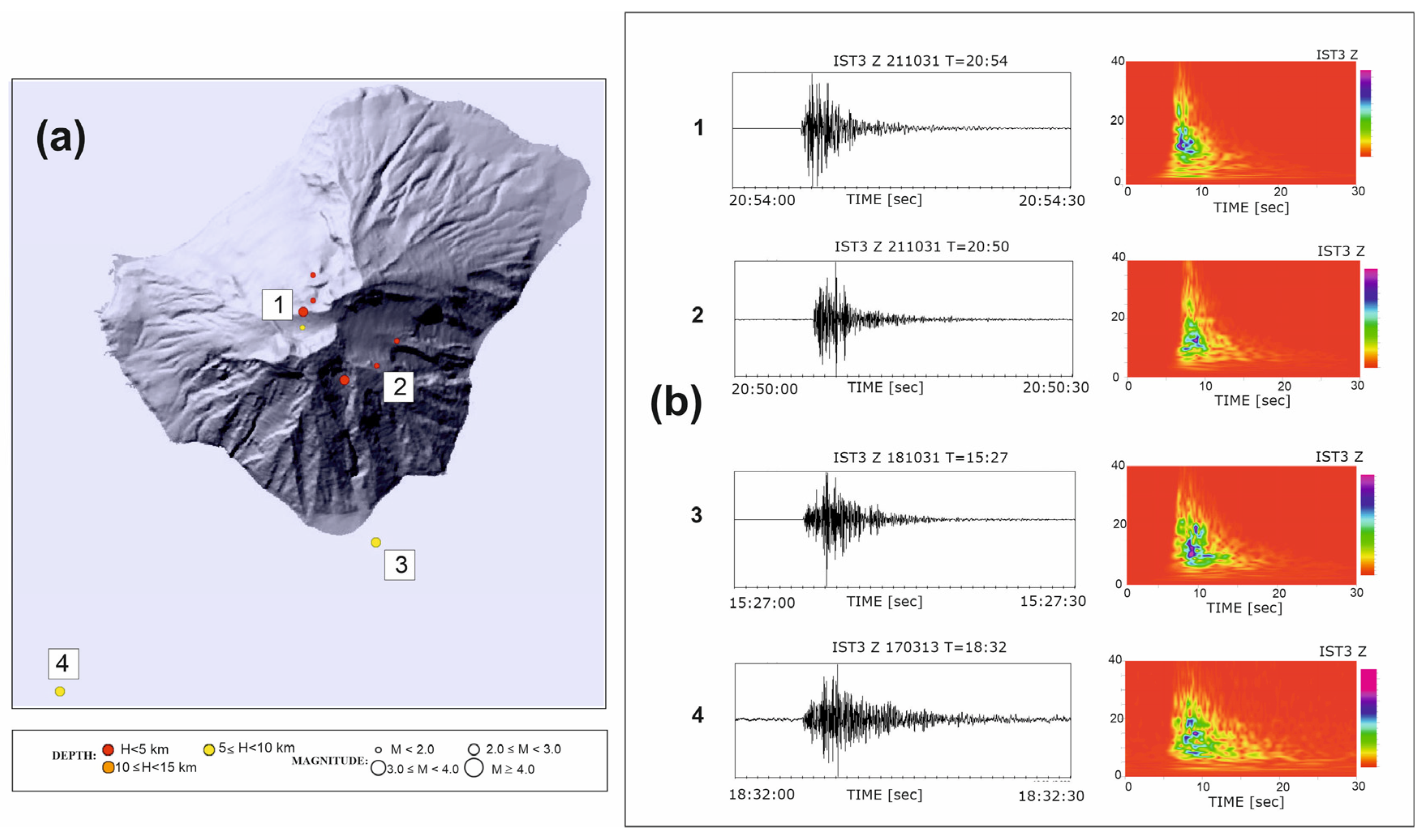
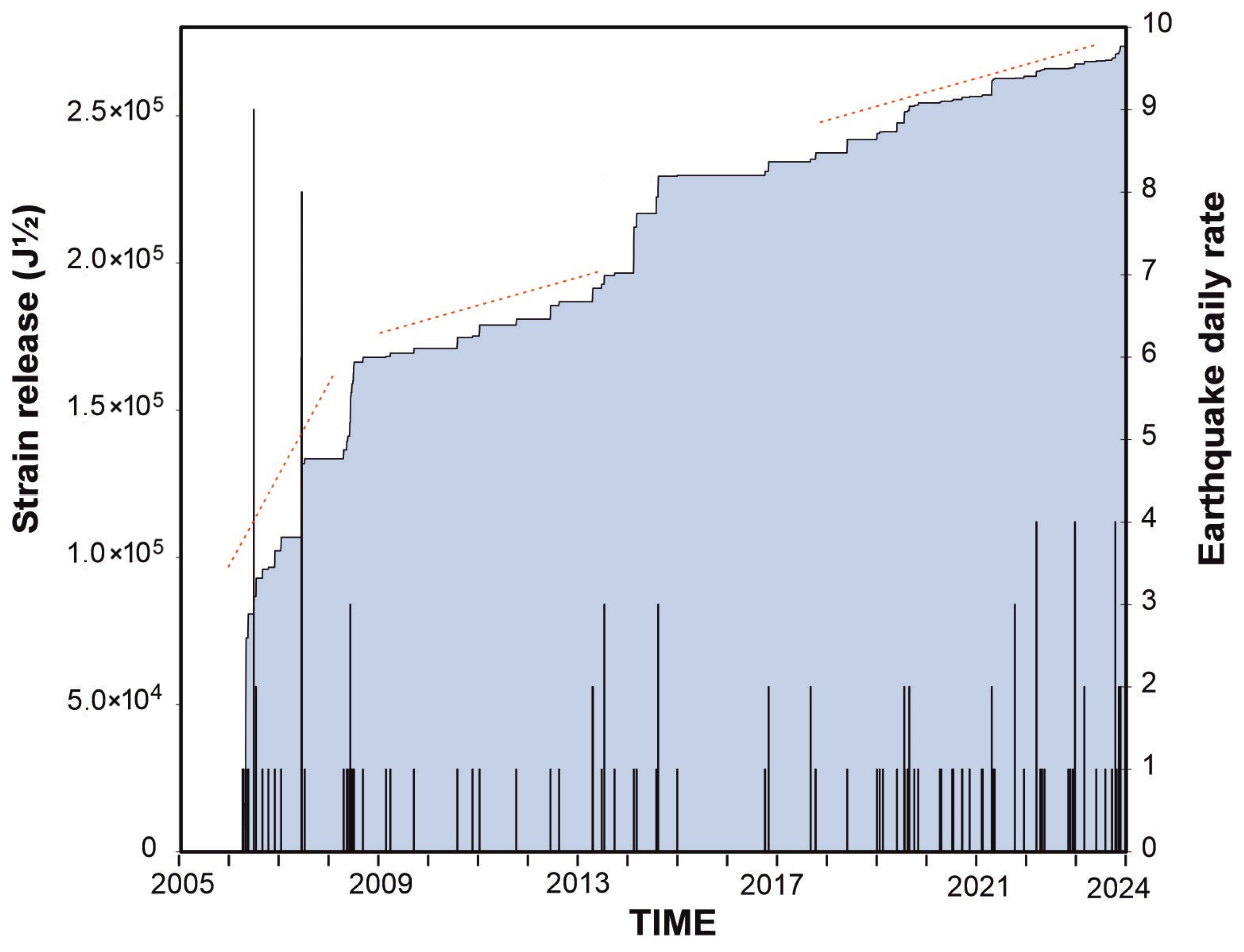

| N | Time | ML | Latitude N | Longitude E | Depth (Km) b.s.l. |
|---|---|---|---|---|---|
| 43 | 2017-03-13 03.02 | 0.7 | 38.791 | 15.214 | 4.7 |
| 44 | 2017-03-13 18.32 | 1.9 | 38.756 | 15.189 | 9.8 |
| 45 | 2018-01-26 17.05 | 1.4 | 38.794 | 15.220 | 1.3 |
| 46 | 2018-03-05 16.11 | 1.1 | 38.795 | 15.214 | 3.0 |
| 47 | 2018-10-31 15.27 | 2.4 | 38.772 | 15.237 | 7.4 |
| 48 | 2019-06-13 13.19 | 1.9 | 38.819 | 15.201 | 5.6 |
| 49 | 2019-07-03 14.44 | 1.4 | 38.788 | 15.220 | 2.0 |
| 50 | 2019-07-28 18.27 | 0.5 | 38.792 | 15.203 | 0.1 |
| 51 | 2019-11-12 03.11 | 1.9 | 38.785 | 15.222 | 2.5 |
| 52 | 2020-01-10 14.35 | 1.2 | 38.822 | 15.254 | 12.4 |
| 53 | 2020-02-14 22.42 | 1.4 | 38.791 | 15.215 | 0.3 |
| 54 | 2020-02-14 23.13 | 1.3 | 38.790 | 15.211 | 0.3 |
| 55 | 2020-03-24 00.41 | 1.1 | 38.803 | 15.213 | 2.4 |
| 56 | 2020-04-22 15.02 | 1.5 | 38.788 | 15.220 | 2.6 |
| 57 | 2021-03-20 13.39 | 1.0 | 38.790 | 15.202 | 1.9 |
| 58 | 2021-03-22 14.38 | 0.9 | 38.796 | 15.199 | 3.7 |
| 59 | 2021-05-17 23.48 | 0.8 | 38.793 | 15.212 | 0.6 |
| 60 | 2021-08-17 22.39 | 0.9 | 38.794 | 15.216 | 0.2 |
| 61 | 2021-10-31 20.50 | 0.9 | 38.794 | 15.211 | 1.3 |
| 62 | 2021-10-31 20.54 | 2.5 | 38.791 | 15.213 | 0.7 |
| 63 | 2021-11-12 16.40 | 1.1 | 38.789 | 15.222 | 3.2 |
| 64 | 2021-11-22 06.39 | 0.8 | 38.800 | 15.208 | 0.1 |
| 65 | 2022-04-25 08.34 | 0.6 | 38.815 | 15.212 | 0.4 |
| 66 | 2022-04-25 08.36 | 0.5 | 38.814 | 15.188 | 0.1 |
| 67 | 2022-04-25 08.48 | 0.5 | 38.818 | 15.204 | 0.2 |
| 68 | 2022-07-03 00.56 | 1.4 | 38.849 | 15.174 | 3.4 |
| 69 | 2022-10-04 05.42 | 1.0 | 38.807 | 15.208 | 9.4 |
| 70 | 2022-10-04 11.51 | 1.3 | 38.807 | 15.223 | 8.4 |
| 71 | 2022-10-04 16.34 | 1.0 | 38.812 | 15.216 | 8.0 |
| 72 | 2022-10-04 22.24 | 1.1 | 38.818 | 15.218 | 7.3 |
| 73 | 2022-10-05 03.31 | 0.7 | 38.797 | 15.214 | 3.6 |
| 74 | 2022-11-02 03.33 | 1.1 | 38.832 | 15.216 | 8.0 |
| 75 | 2022-11-16 02.10 | 1.0 | 38.791 | 15.214 | 3.8 |
| 76 | 2022-12-05 06.59 | 1.2 | 38.795 | 15.212 | 1.0 |
| 77 | 2023-06-04 18.40 | 0.6 | 38.803 | 15.188 | 3.2 |
| 78 | 2023-06-19 05.37 | 0.7 | 38.810 | 15.214 | 2.7 |
| 79 | 2023-07-22 06.29 | 0.6 | 38.790 | 15.209 | 1.6 |
| 80 | 2023-07-24 09.25 | 0.9 | 38.791 | 15.216 | 3.0 |
| 81 | 2023-07-24 09.41 | 1.2 | 38.790 | 15.217 | 2.9 |
| 82 | 2023-07-24 09.42 | 1.3 | 38.790 | 15.214 | 3.4 |
| 83 | 2023-07-24 10.03 | 0.6 | 38.796 | 15.214 | 2.7 |
| 84 | 2023-10-03 01.47 | 1.2 | 38.793 | 15.212 | 3.2 |
| 85 | 2024-03-11 21.37 | 0.9 | 38.782 | 15.176 | 4.5 |
| 86 | 2024-04-30 18.54 | 1.3 | 38.774 | 15.206 | 0.1 |
| 87 | 2024-05-02 12.36 | 1.1 | 38.776 | 15.204 | 4.1 |
| 88 | 2024-05-26 19.38 | 1.0 | 38.781 | 15.210 | 2.8 |
| 89 | 2024-05-26 19.39 | 0.5 | 38.796 | 15.205 | 2.4 |
| 90 | 2024-05-26 19.46 | 1.5 | 38.782 | 15.212 | 3.1 |
| 91 | 2024-05-26 20.57 | 1.1 | 38.786 | 15.210 | 3.4 |
| 92 | 2024-06-04 05.50 | 0.5 | 38.795 | 15.222 | 0.1 |
| 93 | 2024-06-21 06.59 | 1.5 | 38.792 | 15.213 | 2.0 |
| 94 | 2024-06-21 06.59 | 1.1 | 38.791 | 15.214 | 2.0 |
| 95 | 2024-06-30 08.57 | 0.6 | 38.791 | 15.214 | 0.8 |
| 96 | 2024-07-02 18.16 | 1.6 | 38.787 | 15.213 | 1.8 |
| 97 | 2024-07-03 04.04 | 0.5 | 38.794 | 15.212 | 1.3 |
| 98 | 2024-07-04 12.16 | 0.9 | 38.787 | 15.215 | 1.9 |
Disclaimer/Publisher’s Note: The statements, opinions and data contained in all publications are solely those of the individual author(s) and contributor(s) and not of MDPI and/or the editor(s). MDPI and/or the editor(s) disclaim responsibility for any injury to people or property resulting from any ideas, methods, instructions or products referred to in the content. |
© 2025 by the authors. Licensee MDPI, Basel, Switzerland. This article is an open access article distributed under the terms and conditions of the Creative Commons Attribution (CC BY) license (https://creativecommons.org/licenses/by/4.0/).
Share and Cite
Gambino, S.; Scaltrito, A. 2005–2024 Time–Space Features of VT Seismicity at Stromboli: New Insights into the Volcano Plumbing System and Link to Effusive Eruptions. Appl. Sci. 2025, 15, 9182. https://doi.org/10.3390/app15169182
Gambino S, Scaltrito A. 2005–2024 Time–Space Features of VT Seismicity at Stromboli: New Insights into the Volcano Plumbing System and Link to Effusive Eruptions. Applied Sciences. 2025; 15(16):9182. https://doi.org/10.3390/app15169182
Chicago/Turabian StyleGambino, Salvatore, and Antonio Scaltrito. 2025. "2005–2024 Time–Space Features of VT Seismicity at Stromboli: New Insights into the Volcano Plumbing System and Link to Effusive Eruptions" Applied Sciences 15, no. 16: 9182. https://doi.org/10.3390/app15169182
APA StyleGambino, S., & Scaltrito, A. (2025). 2005–2024 Time–Space Features of VT Seismicity at Stromboli: New Insights into the Volcano Plumbing System and Link to Effusive Eruptions. Applied Sciences, 15(16), 9182. https://doi.org/10.3390/app15169182






